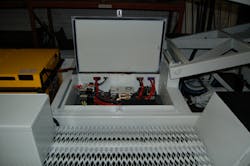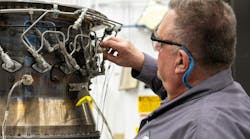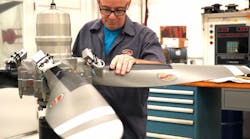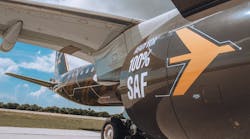With a keener eye toward compliance and more environmentally friendly operations, electric has become an industry buzzword. Beyond new units, there has been another alternative for fleet managers looking to go electric — conversion. Long an option, the idea has yet to take hold throughout the industry, though some say the concept is gaining ground.
Conversion Projects
In 1997, EPRI funded a project to convert a loader owned by Delta Air Lines. The manufacturer, JBT AeroTech, completed the conversion. The unit was placed into operation in Atlanta where operational results were recorded over a period of four months.
According to the EPRI’s report, “The study showed that the electric-powered demonstration pallet loader performed identically to the diesel IC version. The only difference was the need for routine charging.”
The loader was equipped with two 80 volt batteries. Testing showed the unit could operate continuously for 5.8 hours before reaching a 20-percent state-of-charge. “This is more than sufficient for a normal shift, considering the average run time was 1.7 hours per day. The use of opportunity charging in this and similar operations easily permits multi-shift operation,” according to the report.
For JBT, the project provided evidence that conversions could hold up to operational standards of new units. “Some people might expect that if they put in a different motor or different engine in, they would get different performances, and that’s not true,” says Dale Koger, electrical engineering manager at JBT. “The JBT conversion kit meets all operating parameters of the existing machine. The controls are identical and the performance of the machine is identical. You just don’t have the noise or the smoke.”
According to Joe Fuqua, general manager of GSE at Delta, the loader is still in operation today in Atlanta. When asked about potential projects in the pipeline, he says the airline is in talks to convert a pushback tractor.
Ongoing Conversion Efforts
Southwest Airlines has an ongoing conversion project that has completed the conversion of about 150 units. For more than 15 years, the crew at its Phoenix facility has converted pushbacks and belt loaders.
The conversions have been completed in-house with three technicians dedicated to converting two belt loaders a month. According to Larry Laney, director of GSE at Southwest, the conversions make economic sense — with the average conversion coming in at about half the cost of a new unit.
Southwest has been able to keep costs down due in large part that the crew has sourced the kits themselves — an endeavor that required a significant initial investment. “We went and did all the research and development, so that was a challenge — the expense of going through the process to get where we are at,” Laney says.
Rick Waugh, regional manager of GSE at Southwest Airlines, says the crew worked to find parts that were cost effective and easily accessible. “We asked ourselves: What can we do to simplify this process completely? And we didn’t want to reinvent the wheel,” he explains.
“If there is something out there on the market currently that works that is reasonably priced and it will work in our application, then let’s do that,” he says, adding, “Through the procurement process, we tried to find products that are already out there being made. Outside of a gearbox that we need for our belt loaders that was custom made for us, everything else is just off-the-shelf and it’s brought our cost down.”
Conversion Support
Many companies have offered kits and conversion services for GSE. JBT, which offers conversion of loaders as part of its refurbishment services, has introduced a kit for its model Commander 15 loaders for model years 1996 through 2003 for customers looking to complete the process themselves. “We will quote on the first installation with a JBT field service technician to oversee and train their team on the proper installation of the kit,” Koger says. “It’s not overly difficult, but the cost of the main components makes it beneficial for everyone that we make sure it’s installed properly.”
FMI Truck Sales has offered a kit for its Isuzu vehicles since 1999. The company offers the option of producing kits for other types of GSE, but it’s based on volume and demand. “To develop a kit that you put together for a specific model, generally you like to have a little bit of volume, because it’s fairly expensive to design and put together for someone,” owner Don Emerson explains. “We’ve done mostly conversions of on-road vehicles, but have the ability to do belt loaders and anything other than really heavy tugs.”
Tug Technologies has also completed the conversion of its belt loader and now offers a kit for customers to install themselves. “Tug is able to offer a range of solutions from the full conversion and factory rebuild with like new warranty to a customer conversion kit," says Brad Compton, VP sales and marketing at Tug.
Hercules Engine Components has also undertaken conversions for GSE, completing conversions of pushbacks, bag tugs and belt loaders and offers such services for customers.
Technical Skill
For units such as pushbacks and belt loaders, many companies say the process is not overly complicated. Most conversions — excluding any backlog considerations — are about a three-day process.
Emerson of FMI Truck Sales says conversions can be done in-house — when a crew understands the basics. “When you convert a vehicle that is currently set up as a gas or a diesel truck, you obviously have to remove the cooling system, fueling system, the engine, and in some cases utilize the transmission as your drive gear (and some cases you don’t, depending on the application you're into),” he explains. “You’ve got no fuel system and no cooling system, which means no radiator, no fuel tanks, and the engine is gone. You have to stop and think about what gets replaced on those.”
Waugh of Southwest Airlines indicates that technicians should have a strong familiarity with electric equipment. “It takes a knowledge in electric GSE — what all is involved with it, knowledge of the controllers, knowledge of the chargers,” he says. “All this was picked up through trial and error out here in Phoenix. Phoenix has been working with electric from the mid to late 90s. They’ve converted a lot of units, and they were all steps to learn as we progressed on down the road to the product that we’re putting out today.”
Cost
The cost differential for converting versus buying new can vary by unit type. Southwest, through its continued efforts in-house, has been able to convert at about 50 percent the cost of a new unit. This is the average threshold the carrier uses when evaluating projects. “We look at an asset and if we can dump 50 percent of its value into it to create a new asset, then we go for it,” Waugh says. “It makes strong economic sense.”
Jack Dienes, president of Hercules Engine Components, says their conversions have averaged between 50-60 percent the cost of new, which include the refurbishment of units.
Emerson of FMI Truck Sales suggests customers should evaluate the cost return for each type of unit. “A typical kit — by the time you look at something that has power steering and vacuum assist brakes and all those systems you have to convert over — it’s not uncommon for the kit itself to be in the $15,000 to $17,000 range (depending on the horsepower you need),” he explains. “Then depending on what you want you need to add for batteries and so forth, depending on your usage. A battery pack can be another $3,000 to $4,000 if you use lead-acid and more if you go with lithium. You’ve also got labor, which in most cases is about 100 hours for a conversion, give or take 20 on what your trying and how complicated it is.”
Candidates for Conversion
So just what type of units are ideal candidates for conversion? There are differing opinions when it comes to such a question. Some contend that belt loaders, pushbacks and loaders remain the best options, because other units may not be as cost-effective or may present too much of a design challenge.
Southwest has kept large-volume conversions limited to belt loaders and pushbacks. Laney says the team has worked on different types of GSE — such as bag tugs — but has not found the process to make economic sense. “Tugs are not really conducive for the conversion because the large battery pack and the way the engine is designed,” he says. “We haven’t been able to find out a way to really do them that makes sense.”
However, some companies insist tugs are another good option. Hercules Engine Components has completed a tug conversion. Dienes concedes that the unit may not be ideal for all operations. “It is more difficult to do the conversion, because it’s tougher to arrange the batteries,” he says. “And because of that you’re limited on the amount of amp hours you can get out of the series of batteries.”
However, the company has found that smaller airports are an ideal fit for its units. “They may only do five or six flights a day, and that tractor is perfect for that application,” he says.
Another company, A&V Rebuilding recently debuted a tug that it converted using lithium-battery technology, which the company states is superior to a standard a lead-acid battery — performing up to three times as long on each charge, as as well as having life expectancy of up to 12 years or more . (See sidebar)
Wayne Alexander of Electric Blue Auto Conversions — which also offers repowering services for GSE — offers a more liberal view. “Just about any piece of equipment is ideal for conversion,” he says, explaining that while there may be drawbacks associated with some unit types, technology will quickly catch up to address any operational issues.
The true test of candidates for conversion, which nearly everyone agrees upon, is whether or not the infrastructure will support a unit at its location.
More Traction for Conversion?
Conversions from IC units to electric have been a largely sporadic undertaking throughout the industry. It has long been an option, but it has not widely taken hold, though some companies say that could be changing.
Brad Compton of Tug notes that the company has seen more interest in conversions. “I think when they look at converting a current asset, it is more economical. And then you look at all the incentives to go electric, it’s going to happen,” he says.
Compton points to emissions regulations as one factor that could push the industry more toward electric in general — not only conversions, but new builds as well.
That sentiment is shared by Emerson at FMI. “I think that we’re seeing much more conversation about it because of the changes that are coming with the emissions,” he says. “I think that the airlines and the service companies are desperately trying to figure out what direction to go here for the long run with the new rules.”
JBT also agrees. “Interest levels have been very high,” Koger says. “We’re fielding questions on a regular basis. You’re going to see the percentage of electric vehicles, as conversion or new production, continue to grow as money starts becoming available. With the introduction on the Tier 4 engines, customers are looking at the higher cost of Tier 4 and the maintenance involved. They are giving it more of a look to go electric.”





